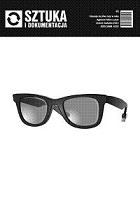Dokumentacja interaktywnych aspektów dzieł sztuki mediów
Documentation of an Interactive Aspect of Media Art Works
Author(s): Weronika DobrowolskaSubject(s): Fine Arts / Performing Arts
Published by: Akademia Sztuk Pięknych w Gdańsku
Keywords: contemporary art; documentation; new media; interactive art
Summary/Abstract: Media art requires that the traditional documenting methods both improve and work out new tools, allowing the documentation to catch specific features and phenomena associated with the functioning of artworks that include unstable, electronic media. One of the phenomena, a characteristic for many media works is an openness towards the interaction of the audience, who may manipulate the work using many interfaces creating their own performance, as well as modify the work within the framework defined by the artist. According to many researchers and artists, the actual artwork is the result of the activities of “inter-actors” who experience it. The traditional methods used by art institutions to document the interactive aspect of the artworks is only to a very limited extent successful. The problem of documenting art created by non-standard media (including electronic media) was undertaken as part of many projects, for example: Documentation et conservation du patrimoine des arts mediatiques (DOCAM), Variable Media Initiative (VM), Capturing Unstable Media (CUM) or the thematic residential programs realised by the Daniel Langlois Foundation. However, not all of the above mentioned projects considered that the problem of interactivity and the experience of the audience had been dealt with thoroughly. In many of them a new theoretical ground taking the concept of both the artwork and the role of inter-actors was created. A few of the proposed solutions were quoted in the article. In the text, various strategies of documenting the interactive aspects of media artworks which result from adopting various perspectives and assumptions were described. These strategies oscillate around two opposing terms: interactivity and interaction, as well as the difference between the will to document an ideal representation of the work (according to the artistic concept) and an attempt to grasp how the work functions in real circumstances together with the more or less successful trials of the inter-actors to experience it. Of particular interest seem to be the attempts to document the experience of the audience and then applying the knowledge achieved to work further with the artwork – to protect it, exhibit it in various ways or allow it to communicate further with the audience.
Journal: Sztuka i Dokumentacja
- Issue Year: 2011
- Issue No: 5
- Page Range: 33-53
- Page Count: 21
- Language: Polish

